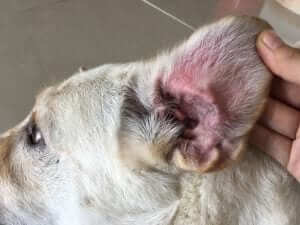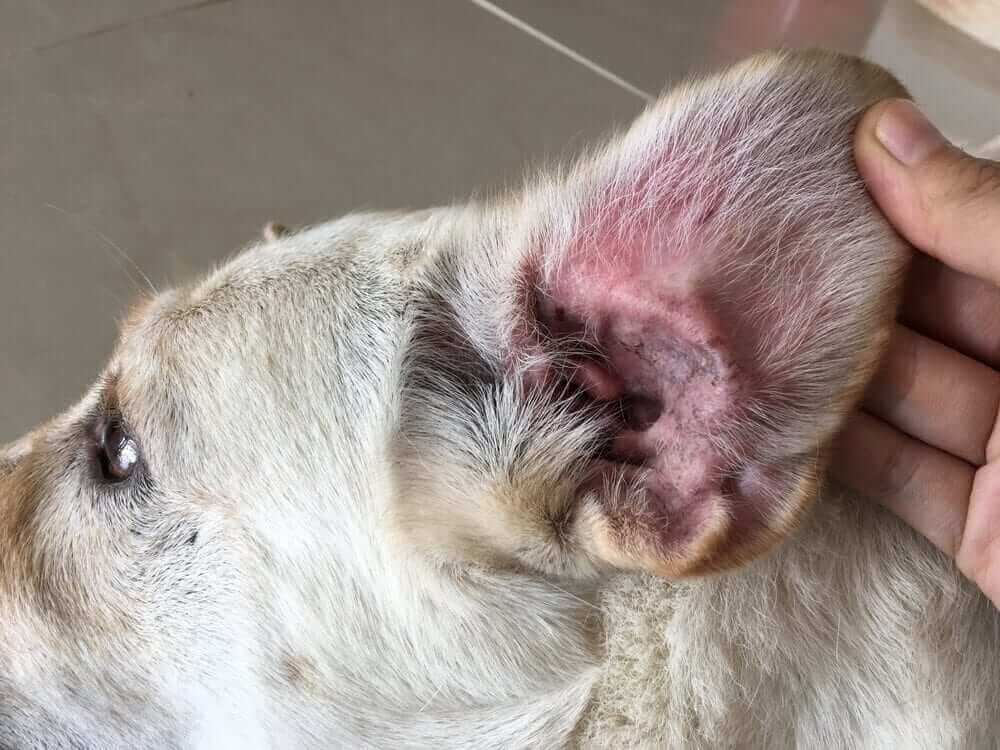Scratching, digging and rubbing their head on the ground can all be signs of an ear infection in your pet. The problem can be not only irritating for the pet, but also for the owner as it can often mean a loss of sleep at night for both parties. Ear infections are more common in the dog than the cat with many causes and predisposing conditions. In most cases, the problems are easily resolved with medications, but in others, the condition can be recurrent, happening over and over again. The good news is that there are options!The dog and cat’s ear is not dissimilar to ours, having an external portion referred to as the pinna. The pinna has an opening that goes into the vertical ear canal which then transverses downward, turns a corner and then becomes the horizontal ear canal, which ends at the eardrum. The ear drum itself divides the ear into an external and internal compartment. On the other s

ide of the eardrum is a network of smaller organs and nerves that allow us to hear, but also help in maintaining balance.
Clinical Signs of Ear Infection in the Dog
The clinical signs of an ear infection correlate with the severity of the condition. In the early stages, there may be an increased scratching of the ear, shaking of the head, rubbing the head on the ground or a moaning or crying noise when you pet them around the ear. In more severe cases, the ear of the dog may be more red, swollen or even have a discharge and odor. As the condition progresses, in some cases, the dog may actually tilt their head towards the affected side or even lose balance and stumble if the inner ear becomes affected. If scratching or head shaking becomes excessive, it is not uncommon to see a massive swelling in the pinna which is termed an aural hematoma and a rupture of blood vessels with blood accumulation.
Causes of Ear Infections in the Dog
Most ear infections in pets are associated with:
- Bacteria
- Yeast
- Parasites
Bacteria are the most common cause of ear infections and often they are mixed infections, which means that more than one type of bacteria is present. In other cases, we have more resistant strains including Pseudomonas, which are more difficult to manage and often secondary invaders due to chronic infections or particular situations.
Yeast are also very common to find in pets, especially in the dog. Their presence is usually indicated by a distinct musty type of odor and a moist discharge with severe head shaking, scratching and discomfort. The most common type of yeast found is Malassezia, which is considered to be an opportunistic organism and not a primary invader. Their presence usually indicates that we have underlying health problems that are allowing for certain factors to be present. Yeast generally love a warm, moist environment which is also acidic, so they are commonly found in pets that swim often or have poor airflow due to hair accumulation.
Parasites are also common invaders with the ear mite being most common in cats. Dogs do experience ear mite infections, but generally when they have the problem it indicates that they have been hanging around with a cat that also has ear mites. They result in severe irritation, resulting in head shaking and scratching. There is generally not an odor but there is a charactertistic brown, waxy discharge.
Secondary or Primary Factors in Dog Ear Infections
Ear infections can occur as primary problems, but more often there are certain circumstances that create the right environment for the problem to exist. The most common factors are:
- Excessive swimming or bathing
- Excessive hair accumulation
- Certain breed predilections
- Concurrent skin allergies
- Concurent dietary allergies
- Concurrent digestive problems
Water accumulation in the ear is very common with swimmers or those that are bathed frequently. This problem is generally easily remedied by using an ear drying cleanser or rubbing alcohol after the bath or swim. In some cases, we would use large balls of cotton placed into the ear during baths to help gather the excess water, but one has to make sure they do not place the cotton too deep so that it is hard to retrieve.
Hair accumulation is another problem associated with certain breeds that require frequent grooming. If the hair accumulates, then air circulation is restricted and waxy debris accumulates. This then allows for bacteria and yeast to accumulate and prosper and create problems.
Certain breeds of dogs are predisposed to ear infections which is usually those breeds with a narrowed ear canal or those breeds that have ears that lay flat on the side of the head and not erect. When the ears lay flat, air flow is again disrupted which creates problems. These breeds include Retrievers, Boxers, English Bulldogs and many others.
In those dogs that tend to have recurrent problems with ear infections, there can often be a correlation with allergies, food intolerances and digestive problems.
Treatment and Management of Ear Infections in the Dog
Most cases of ear infections are treated with topical or oral antibiotics and antifungals if indicated. Ear mites are treated with topical remedies and anti-parasitic medications. In most instances, especially in cases that have discharges, the ear canal will be cleaned and dried to help remove debris and bacteria. Steroids and pain medications may be indicated if the condition has progressed.
The majority of ear infections will generally respond to therapy within a week, but the problem comes as to how to best manage those pets with recurrent or persistent problems. Ear cultures are not commonly done initially, but are more often done in those cases that persist. Often we will have more resistant bacteria, including Pseudomonas, which can create real concerns as it is difficult to eliminate and can be expensive to treat.
The chronic ear infection case is difficult and often we will resort to food trials and diet eliminations to test for food allergies. In other cases, we have skin allergies that are already present with the pet reacting to various allergens in the environment. In those instances and in the case of dietary allergies, we often have an immune response that is not functioning up to par, thus allowing infections to occur secondarily.
What I have found most useful in our chronic cases is to experiement with the diet, getting the owner to actually home cook for the pet in order to eliminate preservatives and additives. I will also add certain herbs to the diet to improve digestion, enhance immune function and reduce ongoing inflammation; all of which contribute to the conditions.
One formula that we have used for many years is a combination of several herbs that impact several aspects. Our Cur-OST® SA Total Support formula helps to manage inflammation, support the immune response and target digestive health through the use of Curcumin, Dandelion, Marshmallow and Parsley in addition to other nutritive herbs that support overall cellular health.
I have found that through the use of this formula in combination with an whole food diet, many ear infections including skin allergies can be more easily managed.
The take home point is that ear infections are common but can become a nuisance for your pet with potentially some long term health consequences and expense. If you own a pet that has more than 2 infections per year, then it is a signal that there may be other problems that need to be addressed.
I hope this helps!
Tom Schell, D.V.M.
Nouvelle Research, Inc.
www.nouvelleresearch.com


